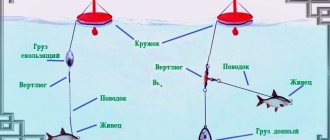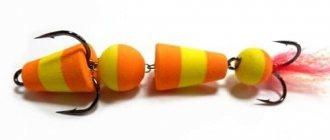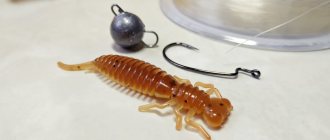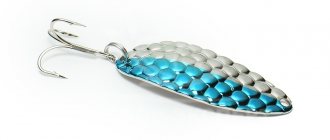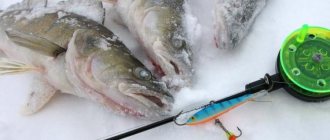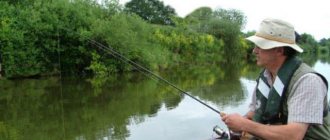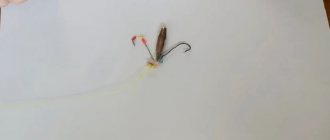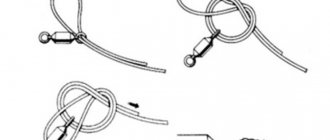Many fishermen claim that catching crucian carp with an elastic band is a real pleasure. This method does not require any expensive materials. The method allows you to catch fairly large specimens of fish by feeding the bait quietly and carefully. The simplicity of the technique allows you to get a large catch in a short time. However, first you need to choose the right fishing location, install the tackle correctly and accurately throw the bait.
Pros and cons of fishing with an elastic band
The method has its advantages and disadvantages. Knowing them, you can understand in which case it is better to use it.
Advantages:
- Possibility of fishing at a fairly large distance from the shore.
- The design of the tackle minimizes the fish falling off the hook and going into the reeds.
- All-weather - the quality of fishing is not affected by wind and rain, which cannot be said about float gear.
- Careful, quiet casting of the bait practically does not scare the fish.
- The bait is delivered exactly to the feeding area.
- The sensitivity of the method allows you to notice the bite of fish of different sizes. Donka with an elastic band has good sensitivity.
- The presence of several hooks on the tackle increases the likelihood of a good bite.
- The design of the gear minimizes the likelihood of entanglement.
- Compactness - the tackle easily fits into a regular backpack.
Flaws:
- Low applicability in overgrown areas
- High probability of getting caught in floating debris
- Difficulty of casting tackle from the shore for beginners
- Low catch in areas with strong currents.
Gear and equipment. Installation
The first thing to start with is the load. It should be of such a weight that the tensile force of the rubber band would not move it towards the shore. And at the same time, not heavy enough to be thrown a sufficient distance.
If you have a boat, then everything changes and becomes simpler here. With a boat, you can take a heavier load and tie more rubber bands, thereby fishing from the distance you want.
A nylon cord no longer than 1.5 m is tied to the load. An elastic band of the length you need is tied to the nylon cord through the winding ring. Then again a winding ring of a larger diameter, and the main fishing line comes from it.
The diameter of the main line is approximately - 0.3 mm + - 0.02 - 0.04. The diameter of the fishing line for leashes varies from 0.18 to 0.22.
The length of the elastic should be selected based on the distance from the shore where you are going to fish.
The elasticity of the elastic increases its length by about 5 times. Thus, if you are going to fish at a distance of 50 meters from the shore, you will need elastic bands: 50/5 = 10 meters. Length of elastic band * 5 = distance from the shore.
The leashes on the main line are attached at a distance of approximately 30 cm from each other. The length of the leash is on average 10 cm. If the leashes cling to the bottom, the length of the leash can be adjusted on the spot.
Hooks for crucian carp fit perfectly under number 10. Just like the leashes, it will be possible to adjust them on the spot and install either smaller or larger hooks.
Advice: do not be afraid of winding rings, swivels and carabiners and knit the equipment using various transitional knots. It is much more convenient to use such accessories for mounting equipment, and rest assured: this will not affect the bite in any way.
Catchable tackle elastic band. Killer of crucian carp and crucian carp (video)
Choosing a place to fish with an elastic band
Arriving at a large body of water, many fishermen are faced with the problem of where to get the “elastic band”. It turns out that choosing a place is not so difficult. To do this, you just need to use three simple rules.
- Firstly, the location from the shore should be comfortable. These can be prepared sites or nickels of a flat bank. The main thing is without gullies or cliffs. The site must be cleared of tall grass and bushes. Usually a clearing 8-10 m in size from the water's edge is enough. If there is no site, prepare it yourself by crushing the grass and cutting down the bushes.
- Secondly, it is necessary to take into account the topography of the bottom of the reservoir. To fish with a rubber band, you need to choose a place with a smooth decline of the bottom from the coastline. Crucian carp, especially large ones, rarely go into shallow water, so the depth at the bait location should be 2-6 meters. If there are sharp dips at the bottom of the reservoir, they try to throw a “rubber band” sinker at the beginning of the rise of the bank from the opposite side of the hole. Thus, the rubber band route will be located above the gap. This option also allows you to catch crucian carp near the reeds.
- Thirdly, you should definitely take into account the presence of a current. Although the bait of the tackle itself, thanks to the heavy sinker, moves slightly from the casting point in strong currents, the feeding spot is washed out very much. Therefore, it is necessary to either choose areas with calm water, or often adjust the position of the sinker taking into account the blurring of the bait.
Elastic band diagram
Depending on the type and size of the trophies, you will need to make some changes in the thickness of the line, the size of the hooks and the length of the leashes. But the basic scheme of such equipment is the same for all types of bottom fishing rods. It got its name from the inclusion of a piece of rubber in the design.
Large cargo is transported by boat or thrown from the shore. A piece of nylon cord is attached to the sinker. A piece of 1-2 meters is quite enough for casting. Several meters of rubber are attached to the cord. The rubber insert is connected to the main line, on which leashes with hooks are located. All individual sections of the tackle are attached to carabiners.
This is a schematic, brief description of the gear. The main thing is to know how to make this type of gear for predators.
How to throw (start) a donk with an elastic band
The easiest way to install gear is to cast a sinker from the shore. If the depth and temperature of the water in the reservoir allow, do this from small shallow water. Before casting, the first thing to check is the integrity of the equipment, the absence of tangled areas, damage, and the reliability of fixation of the sinker and hooks. The length of the leashes and the distance between them should be such that they cannot intertwine with each other. Then the tackle is carefully laid out on the shore so that when casting, the fishing line does not intertwine with each other and does not catch on the grass. There is no need to put on bait when casting. If the cast is successful, this can be done using an elastic band.
Having prepared the tackle, you should place the load in the right place. This is done by unwinding it or gradually swinging it on a rubber cord. An alternative method is to try throwing the sinker with a simple sharp throw with your hand. In this case, the flight range will depend on its mass, shape and throw force. To signal a bite at the end of the tackle, you need to attach a guard to the fishing line. Once the gear is installed, you can begin to attach the bait.
Features of rubber bands for pike perch
Fishing for pike perch with an elastic band uses “live bait” gear. For it, oval and round sinkers are taken, streamlined and without sharp corners, so that the tackle can be easily pulled out by the elastic band. Leashes must be tied, preferably of medium strength and using carabiners. Without them, if a large fish bites, it can damage the fishing line, and the pike will even bite it. In the case of a leash, only the hook will suffer. The last ones for catching pike perch with an elastic band are taken with triple ones.
Some subtleties of installation
- The length of the shock-absorbing rubber band must be at least 10 meters.
- To fasten the elastic, a meter-long piece of fishing line is taken, and specific knots and swivels are used in the process.
- The hook is secured to the leash with a swivel, depending on the fish being caught, for example, for pike perch, take No. 1 - 4.
- Feeders and springs without weight are placed between the leash and the fishing line.
- Be sure to place one end of the elastic on the shore.
- Inclusions with leads are attached only to the stretched shock absorber.
- To securely and firmly secure the fishing line on the shore, you can use a split wooden peg.
- If the fishing distance is significant, then it is better not to throw the load from the shore, but to take it to the desired place on the boat, having previously tied the float.
Nozzle for catching crucian carp
Rolls of bread crumb have proven to be a good bait for catching crucian carp. You can use white or black bread. Many fishermen note that the effectiveness of biting increases if you add butter and cheese. Also, crucian carp bite perfectly on balls of sour dough. Popular baits are boiled grains of corn, pearl barley, and wheat.
If the crucian carp is not too hungry, the fish may react sluggishly to baits. In this case, it is worth switching to bait. You can determine the moment when the fish begins to dig into the mud and air bubbles rise to the surface.
Baits and lures
When catching pike perch using a rubber band, small fish are used. Usually this is a small roach or bleak. It is this type of fish that pike perch bites best at the end of autumn. You can buy it or catch it in advance in the same reservoir.
And frozen sprat also works well as bait.
Artificial baits are also used for pike perch: fish made of silicone or even just ordinary foam rubber. This material is lightweight and well follows the movements of small fish in the current.
Attaching live bait to a hook is carried out in one of the following ways:
- the hook is placed behind the lip;
- under the gills;
- behind the back;
- by the tail.
Attaching live bait to a hook “on the back”
The third method is the most popular; it is also considered universal, suitable for any type of bait. When using a tail bait, the hook is hooked through a thread that is wound around the tail of the bait.
Bait and fishing technique
It is almost impossible to predict in advance what the fish will bite on. Crucian carp are often too capricious and completely refuse plant foods. In this case, the presence of bait will save the situation. Traditional baits of this kind are:
- worm (dung worm, earth worm, crawling worm)
- maggots
- bloodworm
- beetles
- larvae (butterflies, dragonflies)
For successful fishing, it is recommended to have 2-3 types of bait. Many anglers combine baits and baits, thereby increasing the chances of success.
The tactics for catching crucian carp are as follows. The bait is attached to the hooks, the fishing line is gradually released and the tackle returns to working condition. The moment the fish bites will be indicated by a guard and a slightly stretched fishing line. The nature of the crucian's bite is such that at first it takes a closer look at the bait and bites it lightly. During this time the signal will be weak. Then the fish takes the bait completely, the bell signal becomes noticeably stronger. At this moment it is necessary to hook the prey. The hook should be sharp and short. The fish is pulled ashore, the catch is removed and the bait is prepared for the next run.
When fishing for crucian carp, do not forget about the bait, periodically throwing it to the location of the sinker.
After successful fishing, you need to somehow get the rubber band back.
Often, when rolling up the tackle, it may turn out that the load has gone into the mud and gotten caught. A simple piece of advice will help you avoid losses. To pull out the tackle, collect the fishing line up to the elastic band on the reels. Then they raise the elastic band as high as possible, for example, by standing on a small ledge on the shore, and begin to pull the load. At first they pull slowly and carefully. As soon as it is felt that the load has come off the bottom, the tackle is pulled out faster so that the sinker floats rather than drags along the bottom. Article on the topic: Bait for crucian carp
Fishing tactics
Pike perch are caught from the shore using a rubber band. However, fishing is greatly simplified when using a boat. In addition, the use of this watercraft allows you to make tackle of a fairly long length - 50 meters or more. Taking into account the fact that the sinker is brought in and cast from the boat, there is no need to use any tricks when casting by hand.
Casting by hand is a little more difficult. And also with this method of fishing, a certain limitation is imposed on the length of the tackle. When casting by hand, it should be no more than 40 m. If there is no safety line, it is recommended to attach a separate leash holder to the sinker, which will protect the tackle from stretching the rubber or breaking it.
You can avoid hooks getting tangled when casting by doing the following:
- The main line is attached to the flexible part.
- The main line is pulled out until it meets the elastic band.
- A supporting line is installed in its place.
- After baiting the bait on the hooks, the rubber band should be released into the water.
The tackle must be kept taut at all times. At the same time, you can easily feel even the slightest vibration when biting. After casting, you need to attach the end of the tackle on the shore to some kind of flexible holder, for example, a branch, a pin driven into the ground, a special fishing rod, etc. Then you need to attach some kind of signaling device to the fishing line, for example, a bell or a bell. Such a device will be especially relevant in conditions of poor visibility (at night, in fog, etc.)
Rubber in installed condition
In fact, this is where it all ends, since the pike perch hooks itself. The fish swallows the bait and fits tightly onto the hook, after which it begins to rush around the tackle. At the same time, the elastic band stretches, protecting the fishing line from tearing.
The fisherman is advised not to pull out the pike perch immediately, but to wait a while until the fish gets a little tired. When fishing, the tackle should also be kept taut; You can’t let go of it so as not to run into the hooks. To avoid injury, it is recommended to make a loop at the end of the supporting line for attaching to a pin or spear driven into the ground.
Important! When pulling, the line should be carefully laid on a clean surface or wound onto a reel.
Features when fishing with a rubber band for some types of fish
Tightening sabrefish with a modernized elastic band
This fish is caught from late spring, the beginning of spawning, and until the beginning of autumn. Zhor can last even after the end of spawning. The main feeding area of sabrefish in summer is located near shallows, sandy and pebble. Closer to spring, the fish slide into deep-sea holes.
Since sabrefish feeds mainly in the upper layers, the main difference in the structure of the tackle is the presence of a float between the elastic band and the main fishing line. It comes in a variety of modifications. This includes a simple foam ball with a through hole through which the main line is passed several times, and commercial plastic floats. The most convenient is a spherical plastic float with two ears (Cheburashka design), which is also used for live bait fishing.
Structurally, the rubber band for hunting sabrefish consists of the following elements:
- sinker;
- shock-absorbing rubber cord;
- holding float;
- leashes on swivels;
- main cord;
- reel;
- cord for removing the sinker, with or without a float, depending on the type of casting.
Recommended reading: Choosing the best wobbler for trolling
One of the most popular baits when fishing for sabrefish are maggots, which are placed on a hook in a garland of 4 pieces, piercing them near the thickening of the body, and the 5th piece covers the tip of the hook, placing it along the entire body.
You can also use artificial bait, such as foam balls. Artificial maggots have proven themselves well. To make it, you need to take finely porous foam rubber, cut it into proportionate pieces and soak it in salted, loose egg white, and then cook in boiling water for a minute.
Chekhon is a relatively peaceful fish; in the fall it can be caught with small live bait, fry or artificial silicone bait, for example, a light-colored twister (white or yellow).
A necessary condition for catching sabrefish with an elastic band is playing with bait, since the fish responds better to a moving bait. The technique is as follows:
- the main line is slightly pulled up;
- after 5 seconds, slowly release to arm’s length;
- there is a pause of 3 seconds, followed by a sharp hook;
- everything repeats itself from the beginning.
- If the bite is bad, then it is necessary to vary the speed of performing the stages; it also happens that the saberfish takes a calmly hanging bait.
We must not forget that feeding fish greatly increases the likelihood of a positive fishing outcome. The first way to attract the attention of sabrefish is to modify the elastic tackle, and a prerequisite is the delivery of the sinker by boat. A net with a fine mesh is tied to the cord for the recess with a float, into which the complementary foods are placed. The current washes out pieces of bait and carries them downstream. Flocks of sabrefish show interest specifically in the source of food, showing little interest in small fractions, so they swim specifically to the feeder.
As a filler, you can use a mixture of millet porridge and egg, diluted with ground breadcrumbs in equal parts. The technology for preparing porridge is as follows:
- take half a glass of millet and the same amount of egg, pour it into the pan;
- add a couple of glasses of water;
- bring to a boil and cook over low heat, stirring occasionally, until the water is completely absorbed by the cereal.
The second method can also be used when fishing without a boat. To do this, you need to take a small plastic bottle (~0.2 l) and drill small holes in it. Then tie it to the main line closer to the float. Complementary feeding is provided as needed.
Fishing for pike perch using an elastic band in the dark
Pike perch also hunts at night. Since this is a predatory fish, the bait is a fry, and it doesn’t matter if it’s alive or dead. Large fish can be cut into portioned pieces, and the tail part of the pike perch seems much more attractive than the head. The main diet is ruff or bleak.
The main hunting grounds are places with sharply changing bottom topography. Here it is better to install several rigs equipped with 3-4 hooks than one with 10. The casting range is also minimal, not exceeding 20 meters, so when delivering the sinker you can do without a boat.
Structurally, the gear structure is somewhat modified relative to the classic version and consists of the following parts:
- sinker, cord and shock-absorbing elastic, mounted in the usual way;
- to connect the elastic band and the main cord, a light (30-40 grams) weight with two eyes, “Cheburashka” type, is used;
- beads to limit the movement of the leashes are located at a distance of half a meter in the movement zone of the fastening carabiner and 2 meters from the central parts of these sections (from each other).
No feeding is required during fishing. This gear can also be used to hunt other predators, for example, perch in the daytime. When the air temperature becomes sub-zero and the water becomes very cold, burbot can be caught very well at night using an elastic band. As a bait, you can use any animal origin, and it’s good if it’s slightly rotten; burbot is an orderly for water bodies and reacts positively to this smell.
Fishing for crucian carp using a tackle with an elastic band
Crucian carp is a peaceful fish belonging to the carp family, so everything written can be used when fishing for carp, bream, roach, etc. It must be remembered that crucian carp are most active in the early morning, before 10 o’clock and late in the evening, although there were cases when the fish was “walking” - it was caught all day. However, specimens weighing more than 500 grams are found only at dawn. You need to look for crucian carp in swampy ponds with a muddy bottom or at the edge of aquatic vegetation, since they find everything they need there - food and shelter.
A distinctive feature of the elastic tackle for crucian carp is the presence of feeders from feeders on it; the fishing tactics are borrowed from the tackle of the same name, however, the elastic has an undeniable advantage - noiselessness and high accuracy of delivery of complementary food to the fishing site. To set up the gear, spring feeders are installed in the space between the leashes and filled with the necessary mixture. The remaining stages of fishing are similar to traditional methods.
Various cereals with flavoring and aromatic additives are used as complementary foods: sunflower cake, hemp oil, anise oil, crackers, etc. You can also use store-bought complementary foods as a base.
A variety of options are also used for the nozzle. These include dung worms, maggots, steamed pearl barley or peas, pickled corn, bread crumbs and dough. Moreover, various oils are often added to the latter; anise and garlic are considered the most popular.
As you can see, the elastic band is a very versatile tackle. With the right choice of place, you can try out a wide variety of lures, lures and attachments, thus studying the habits of fish in the fished body of water. Consequently, the elastic band can also act as an auxiliary tackle. As an independent fishing tool, it is very effective and will help the fisherman if he needs to return with a good catch.
Advantages and disadvantages
The advantages of this gear are:
- The ability to cover all coastal depths without changing the location of the gear.
- Using a large number of baits, both live and artificial, at the same time. At the same time, their combination is allowed if it is necessary to find out what type of fish is present in the reservoir.
- There is no need to transfer the sinker when fishing for fish and changing the nozzle.
- Possibility of quickly changing leashes in case of breaks or snags.
- Use from both boat and shore.
- Compact transport dimensions. The tackle can fit into any fishing backpack, bag or bag.
Flaws:
- The complex design of the gear with many hooks and leashes contributes to snagging and twisting of the leashes with the main fishing line.
- When casting over long distances, extraordinary strength or a floating device is required.
- In medium and strong currents, sailing of the gear is observed. It is stretched with the flow in the form of a parabola, which does not have the best effect on sensitivity and hooking.
- Often, in the current, hooks collect floating debris such as twigs and algae.
Who and where can you catch with a rubber band?
You can use the tackle on a body of water with standing water or slow current. Suitable: lakes, river pools, reservoirs. There should be no algae or snags in the fishing area. You can catch both predatory and peaceful fish. Basically, the following fish are successfully fished with an elastic band: crucian carp, bream, roach, rudd, pike, pike perch, and perch. But for each type, small adjustments should be made. This mainly concerns the replacement of leashes and hooks, as well as the bait used.
How to increase your fish catch? ">
Over 7 years of active fishing, I have found dozens of ways to improve the bite. Here are the most effective ones:
- Bite activator . This pheromone additive attracts fish most strongly in cold and warm water. Discussion of the bite activator “Hungry Fish”.
- Increased gear sensitivity. Read the appropriate manuals for your specific type of gear.
- Pheromone -based lures .
How to create tackle with your own hands
It is best to start manufacturing with a load. There are anglers who use a magnet from a transformer, although a regular lead weight weighing 200 grams or more would be an excellent option.
The most important thing is that this element weighs a lot. Otherwise, when replacing the nozzle, it will begin to move, which will indicate poor quality of the component.
At the same time, you need to make sure that the weight is not heavy, because somehow it will need to be pulled out from the shore.
Some fishermen use a railroad spike. It is good because when it sinks to the bottom, it clings to it with its “hat”. In addition, it is quite easy to hold in your hand. If this is how the load is used, then the elastic band in this case clings directly to the “hat”. If you cannot find anything suitable, do not despair, because there is a way out of the situation. You need to take a regular plastic bottle and fill it with pebbles or something similar to make the element a little heavier. Considering that there are plenty of these bottles everywhere, it will be possible to clean up nature a little and find a suitable part for yourself.
Read: Techniques and tactics for catching bream with boiliesAfter the important component has been found, you can continue to make the tackle with your own hands.
Everything is done like this:
The elastic band should be tied to the load
As for the size, it is calculated based on the fact that the length will increase several times when stretched, so you should not take large elements, otherwise it will no longer be an elastic band, but a thread. It is important to make sure that the two components are well tied; if this is not the case, the weight will remain at the bottom and the elastic will return back. If the load has edges, it is recommended to tie the elastic band through ropes or something similar so that the main element does not fray, since then it will have to be changed regularly. At the other end of the elastic you need to make a loop and tie the main fishing line to it
As for its cross-section, it depends directly on the type of fish. If you plan to fish for small prey, then the diameter of the thread can be thin. With large specimens, the fishing line for crucian carp needs a denser one. After this, leashes and hooks are tied to the main line. If the fisherman knows for sure that there are big fish in the river, then it is better that the leashes are the same diameter as the main fish. In this case there is no point in taking a smaller line. We need to say a few words about hooks. They sometimes get stuck during work and transportation. And in order to avoid this, you need to attach pieces of insulation or cambrics to the fishing line (where the hooks are threaded). The free end of the line is tied to a reel or fishing rod.
